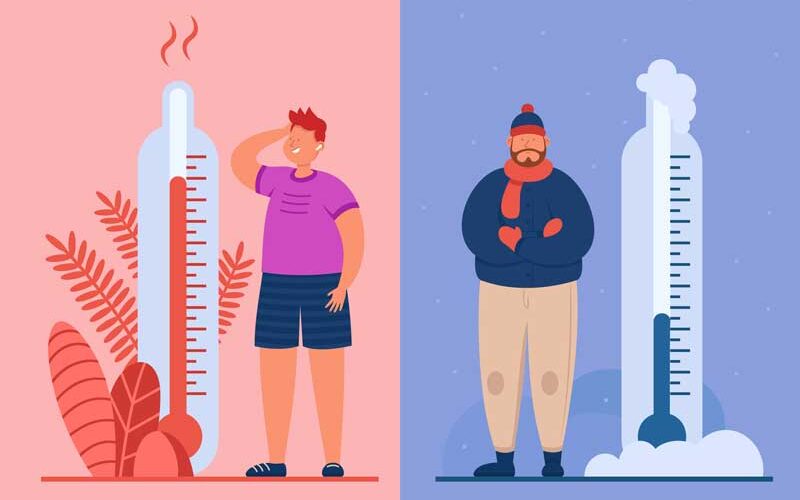It is easy to assume that completing tasks becomes more difficult when studying and working in extreme heat or cold. Our hands and feet hurt from the bitter cold, and we become bewildered in the intense heat. When we are in a hot or chilly room, our productivity decreases. In a certain situation, what is the state of our cognitive function? Do the reactions to such temperature differences vary based on gender? In order to identify the ideal room temperature for employees and to better understand any potential association between workplace temperature and worker productivity or cognitive function, this study investigates the relationship between those two variables.
Our cognitive function is dependent on temperature.
Research indicates that noteworthy associations exist between body temperature and mental abilities. Three experiments were carried out to investigate the relationship between temperature and cognitive performance by researchers Venessa M. Patrick from the University of Houston and Amar Cheema from the University of Virginia. People were given instructions to examine and edit an article in various settings for the first study. Some participants worked in a warm area that was 25 degrees Celsius, while others were positioned in a cold room that was 19 degrees Celsius. The study’s findings showed that the two groups’ performance differed significantly. Almost half of the spelling and grammar mistakes in the article were missed by the participants in the worm room. In contrast, participants in a cold room only missed approximately a quarter of the errors. Another experiment was conducted in the same setting: a worm house and a cold room. Participants were presented with a choice between two cell phone plans this time. The choices are either a plan that is appealing on the surface but is more expensive or a plan that is more complex but is cost-effective. Half of the participants in the cold room chose a cost-effective plan, but only a quarter of the participants chose the plan in the warm room. This study suggests that higher temperatures lead one to make decisions based on simplistic patterns. In the last experiment, participants were assigned to select either innovative products or traditional products, both in warm and cold environments. Participants situated in the warm room selected conventional products. This trait suggests that warm temperatures discourage individuals from processing the relevant information for complex decisions and even lead them to avoid making such decisions (Ward, 2013).
Gender differences in cognitive function in response to room temperature
The study discovered that there is a gender difference in response to workplace temperature in terms of productivity. The researchers experimented on 543 individuals of both genders in Germany to assess their cognitive performance. Participants were assigned math problems when the temperature in the room ranged from approximately 16 to 32 degrees Celsius. They found that women tend to perform better when the temperature increases. When the room temperature increased by half a degree Celsius, women correctly answered these cognitive tasks by 1.76%. On the other hand, per half a degree Celsius increase, the correctness of the tasks for men decreased by 0.63% (Miller, 2019).
What temperature is the best fit for the workplace?
Finding the ideal temperature for the office is essential to maximizing our cognitive capacities and productivity because even a small temperature change may have an impact on our output. According to the study, the best temperature range for employee productivity at work is between 21 and 25 degrees Celsius. Additionally, this study showed that our production might drop by 2.2 percent for every half-degree Celsius increase in temperature (CTC CORP, 2022).
Conclusion
In a nutshell, the link between worker productivity, or cognitive capacity, and the workplace was the main emphasis of this study. Numerous studies have demonstrated that temperature significantly affects cognitive function, with lower temperatures demonstrating greater task performance and higher temperatures causing poorer performance or even aversion to performing hard activities. Gender disparities were also seen; women performed their jobs more accurately when the room temperature rose, but men’s accuracy decreased. The study concludes that in order to enhance worker productivity, the ideal working temperature is between 21 and 25 degrees Celsius. To enhance its comfort level, this may be used both at home and in the office.
Reference
CTC CORP. (2020). How Workplace Temperature Affects Productivity. Available at: https://www.ctc-corp.net/blog/workplace-temperature-productivity/#:~:text=They%20repeated%20the%20same%20study,reduced%20speed%2C%20and%20reduced%20concentration [Accessed 14 July 2023].
Miller, R. W. (2019). Cold offices could make women less productive at work, study finds. Available at: https://www.usatoday.com/story/news/health/2019/05/23/cold-offices-may-hurting-womens-productivity-study-says/1204020001/ [Accessed 14 July 2023].
Ward, A. F. (2013). Winter Wakes Up Your Mind–and Warm Weather Makes it Harder to Think Straight. Available at: https://www.scientificamerican.com/article/warm-weather-makes-it-hard-think-straight/ [Accessed 17 July 2023].
